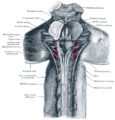
Fasciculus cuneatus
Encyclopedia
The fasciculus cuneatus (tract of Burdach, named for Karl Friedrich Burdach
) is a tract of nerves in the spinal cord which primarily transmits information from the arms. It is part of the posterior column-medial lemniscus pathway
.
and the posterior column
, its base corresponding with the surface of the medulla spinalis.
Its fibers, larger than those of the fasciculus gracilis, are mostly derived from the same source, viz., the posterior nerve roots.
Some ascend for only a short distance in the tract, and, entering the gray matter
, come into close relationship with the cells of the dorsal nucleus; while others can be traced as far as the medulla oblongata
, where they end in the gracile nucleus
and cuneate nucleus
.
information from spinal nerve
s located in dermatome
s C1 through T6.
The 2nd order neurons decussate in the brainstem and continue on to the thalamus
where the 2nd order neurons synapse onto 3rd order neurons.
The 3rd order neurons carry the received signals to the somatosensory cortex where the signals, in the form of action potential
s are interpreted.
Karl Friedrich Burdach
Karl Friedrich Burdach was a German physiologist, born in Leipzig.He was graduated in medicine there in 1800; became professor of physiology in the University of Dorpat in 1811, and four years later took a similar position at the University of Königsberg.He provided in 1822 the name--due the...
) is a tract of nerves in the spinal cord which primarily transmits information from the arms. It is part of the posterior column-medial lemniscus pathway
Posterior column-medial lemniscus pathway
The posterior column-medial lemniscus pathway is the sensory pathway responsible for transmitting fine touch, vibration and conscious proprioceptive information from the body to the cerebral cortex; as well as tactile pressure, barognosis, graphesthesia, stereognosis, recognition...
.
Physical characteristics
The fasciculus cuneatus is triangular on transverse section, and lies between the fasciculus gracilisFasciculus gracilis
The fasciculus gracilis is a bundle of axon fibres in the posterior column of the spinal cord and carries information from the middle thoracic and lower limbs of the body...
and the posterior column
Posterior column
thumb | right | Cross-section of the spinal cord Posterior column or dorsal column refers to the area of white matter in the dorsomedial side of the spinal cord. It is made up of the fasciculus gracilis and fasciculus cuneatus and itself is part of the dorsal funiculus...
, its base corresponding with the surface of the medulla spinalis.
Its fibers, larger than those of the fasciculus gracilis, are mostly derived from the same source, viz., the posterior nerve roots.
Some ascend for only a short distance in the tract, and, entering the gray matter
Gray Matter
"Gray Matter" is a short story by Stephen King, first published in the October 1973 issue of Cavalier magazine, and later collected in King's 1978 collection Night Shift. It is set in the same area as King's novel Dreamcatcher.-Setting:...
, come into close relationship with the cells of the dorsal nucleus; while others can be traced as far as the medulla oblongata
Medulla oblongata
The medulla oblongata is the lower half of the brainstem. In discussions of neurology and similar contexts where no ambiguity will result, it is often referred to as simply the medulla...
, where they end in the gracile nucleus
Gracile nucleus
Located in the medulla oblongata, the gracile nucleus is one of the dorsal column nuclei that participate in the sensation of fine touch and proprioception of the lower body...
and cuneate nucleus
Cuneate nucleus
One of the dorsal column nuclei, the cuneate nucleus is a wedge-shaped nucleus in the closed part of the medulla oblongata. It contains cells that give rise to the cuneate tubercle, visible on the posterior aspect of the medulla...
.
Function
The Fasciculus cuneatus transmits fine touch, fine pressure, vibration and proprioceptionProprioception
Proprioception , from Latin proprius, meaning "one's own" and perception, is the sense of the relative position of neighbouring parts of the body and strength of effort being employed in movement...
information from spinal nerve
Spinal nerve
The term spinal nerve generally refers to a mixed spinal nerve, which carries motor, sensory, and autonomic signals between the spinal cord and the body...
s located in dermatome
Dermatome
Dermatome may refer to:*Dermatome , a surgical instrument used to produce thin slices of skin*Dermatome , an area of skin that is supplied by a single pair of dorsal roots*Dermatome...
s C1 through T6.
Neurons
The Fasciculus cuneatus tract is composed of 1st order neurons that synapse onto 2nd order neurons in the brain stem.The 2nd order neurons decussate in the brainstem and continue on to the thalamus
Thalamus
The thalamus is a midline paired symmetrical structure within the brains of vertebrates, including humans. It is situated between the cerebral cortex and midbrain, both in terms of location and neurological connections...
where the 2nd order neurons synapse onto 3rd order neurons.
The 3rd order neurons carry the received signals to the somatosensory cortex where the signals, in the form of action potential
Action potential
In physiology, an action potential is a short-lasting event in which the electrical membrane potential of a cell rapidly rises and falls, following a consistent trajectory. Action potentials occur in several types of animal cells, called excitable cells, which include neurons, muscle cells, and...
s are interpreted.
Additional images
 |
 |
 |
 |
 |

